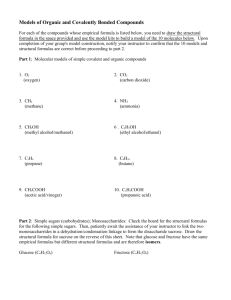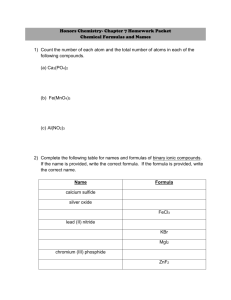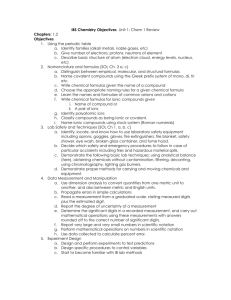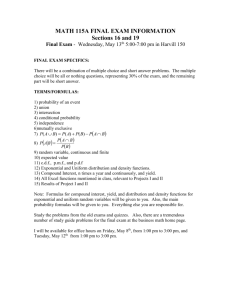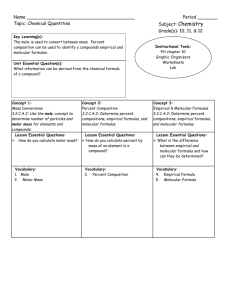APChem chapter 3 pp
advertisement
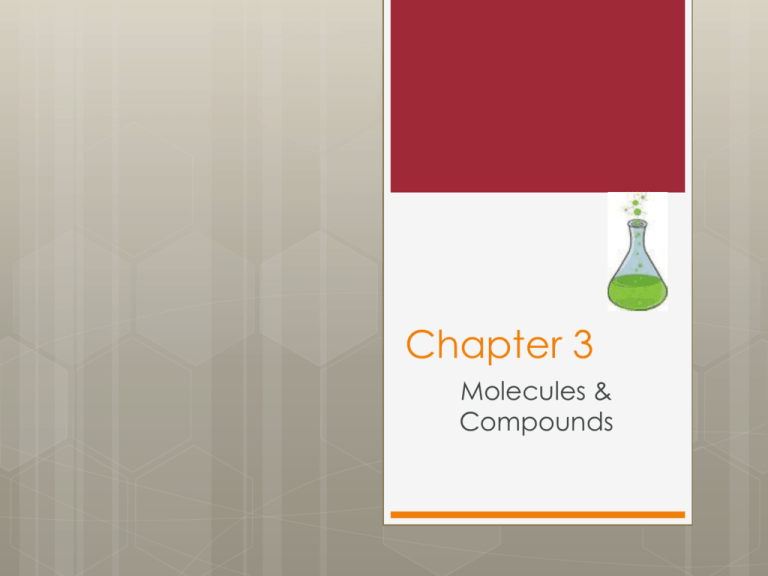
Chapter 3 Molecules & Compounds 3.1 Molecules, Compounds and Formulas Empirical Formulas Definition: the simplest whole number ratio for the formula of the elements in a compound Examples: NaCl, MgCO3, AlBr3 Ionic Compounds: a compound consisting of oppositely charged ions held together by electrostatic attractions Molecular Formulas Definition: a formula consisting of the exact number of atoms of each element in a molecule of a compound Examples: C6H12O6, CO2, SiO2 Condensed structural formulas – formulas depicting some of the bonding by groupings CH3OH , CH3CH2CH2Cl Molecular formulas Condensed structural formulas – formulas depicting some of the bonding by groupings CH3OH , CH3CH2CH2Cl Structural formulas A two dimensional representation of the atoms and bonds http://www.shef.ac.uk/~chem/vepr/ 3.3&3.4 Ionic Compounds: formulas, Names and properties Definition: compounds containing a cation and an anion electrostatically bonded (due to transfer of electrons) Binary Ionic Formulas – binary means two ion types in the compound Charges for Main Group Elements +1,+2,+3, skip, -3,-2,-1, NG Examples Li and O Now you try… Binary compound naming The metal goes first always – element name The nonmetal goes second with an –ide at the end MgS – magnesium sulfide Keep going 6. Transition Metals Stock system – a system of using Roman Numerals to name transition metal cations; the Roman Numeral is the charge on the metal ion Ex 3.3 Ag (I) and I Ni (II) and Cl One more time…keep on going Polyatomic ions: Multi-atom ions that are covalently bonded within the ion Memorize the flash cards provided Ex 3.4 NaNO3 NaNO2 Your turn … Properties of ionic compounds Characterized by the electrostatic attraction between elements Solids at room temperature High melting points Brittle Conduct electricity in the molten state Conduct electricity as solutions (electrolytes) Molecular Compounds: formulas, names and properties Properties: smaller compounds are gases and liquids at room temperature. Large compounds have low melting points, are brittle, and characterized by covalent bonding Writing formulas: prefixes Mono Di Tri Tetra Penta 1 2 3 4 5 Hexa Hepta Octa Nona Deca 6 7 8 9 10 Name the following molecular compounds P2O7 SCl3 CF4 N2O5 CO CO2 H2O Write the formulas for: Diboron trioxide Tetraphosphorus trisulfide Arsenic pentoxide Phosphorus trichloride Diarsenic heptoxide 3.6 Formulas, Compounds, and the MOLE 1. How many moles of CaCO3 can produced starting with 4.22 x 1025 atoms of oxygen and an excess of carbon and calcium atoms? 2. How many atoms of each kind are present in 3.44 moles of dinitrogen heptoxide? N2O7 Determining Compound Formulas Percent composition: The percentage of the elements of a compound or parts of a mixture; must total = 100% Determine the percent by mass of each of the elements in CO2 Determine the percent composition of sodium bicarbonate. Intensive property Property that is independent of the size of the sample of a substance Examples: density, solubility, reactivity with acid, melting point, boiling point Meaning of subscripts The number of atoms present in the molecule or ionic compound NOTE: empirical formula gives the smallest whole number ratio Meaning of subscripts Represent the number of atoms or ions present in the molecule or ionic compound NOTE: empirical formula gives the smallest whole number ratio Empirical and molecular formulas from experimental data Steps: 1. Mass percents are equivalent to masses in grams 2. Convert masses to moles 3. Find the mole ratio (divide by smallest) 4. These ratios are the subscripts in the empirical formula Ex3.11Cassiterite is 78.8% tin and 21.2 % oxygen Determine is empirical formula. Ex3.12 Analysis of 47.25 mg sample of aluminum chloride showed that it contained 9.56 mg of Aluminum. Determine the empirical formula of the compound. Ex 3.13 A molecular substance is 83.6% carbon and the remaining portion is hydrogen only. Determine its molecular formula if the formula mass is about 86 g/mole. Ex 3.14 A compound of silicon and fluorine is found to contain 33.01% SILICON AND 66.99% FLUORINE. Its molar mass is 170 +/- 5 g/mole. Determine the empirical and molecular formulas. Hydrated compounds Ionic compounds that have water within the crystalline structure CuSO4.5H2O Ex 3.15 A hydrate of magnesium chloride consists of 36.2% water What is the correct formula for this hydrate Answer :MgCl2. 3 H2O Ex 3.16 Determine the number of waters of hydration for nickel (II) chloride from the following lab data. Initial mass of nickel(II)chloride hydrate Final mass of anhydrous salt 0.235g 0.128g NiCl2 0.128 g (1 mol/129.5984g) = 9.8766 x10-4 mol X 0.107 g (1 mol/18.016 g) H2 O = 0.005939 mol Divide by the smallest to get ratio 6:1 NiCl2 . X H2 O HOMEWORK #1 11, 13, 33, 35, 37, 89 Worksheet #2 41, 43, 45, 47, 49, 51, 53 #3 55, 57, 77, 83 #4 61,63, 85, 87, 93, 97, 99 #5 105, 107, 111, 113
